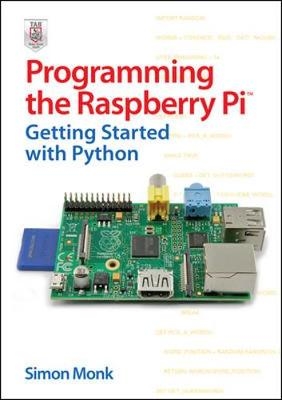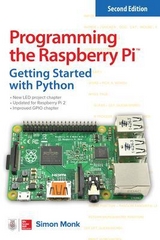
Programming the Raspberry Pi: Getting Started with Python
TAB Books Inc (Verlag)
978-0-07-180783-8 (ISBN)
- Titel erscheint in neuer Auflage
- Artikel merken
Program your own Raspberry Pi projectsCreate innovative programs and fun games on your tiny yet powerful Raspberry Pi. In this book, electronics guru Simon Monk explains the basics of Raspberry Pi application development, while providing hands-on examples and ready-to-use scripts. See how to set up hardware and software, write and debug applications, create user-friendly interfaces, and control external electronics. Do-it-yourself projects include a hangman game, an LED clock, and a software-controlled roving robot.
Boot up and configure your Raspberry PiNavigate files, folders, and menusCreate Python programs using the IDLE editorWork with strings, lists, and functionsUse and write your own libraries, modules, and classesAdd Web features to your programsDevelop interactive games with PygameInterface with devices through the GPIO portBuild a Raspberry Pi Robot and LED ClockBuild professional-quality GUIs using Tkinter
Dr. Simon Monk has a degree in Cybernetics and Computer Science and a PhD in Software Engineering. He spent several years as an academic before he returned to industry, co-founding the mobile software company Momote Ltd. Dr. Monk has been an active electronics hobbyist since his early teens and is a full-time writer on hobby electronics and open source hardware. He is the author of numerous electronics books, including 30 Arduino Projects for the Evil Genius and Arduino + Android Projects for the Evil Genius, as well as co-author of Practical Electronics for Inventors, Third Edition.
Chapter 1. IntroductionWhat is the Raspberry Pi?
What can you do with a Raspberry Pi?
A Tour of the Raspberry Pi
Setting Up
Booting Up
Summary
Chapter 2. Getting StartedLinux
The Desktop
The Internet
Applications
Internet Resources
Summary
Chapter 3. Python BasicsWhat is a Programming Language?
IDLE
Numbers
Variables
For Loops
Simulating Dice
If
While
Summary
Chapter 4. Strings, Lists and DictionariesString Theory
Lists
Functions
Hangman
Dictionaries
Tuples
Exceptions
Summary of Functions
Summary
Chapter 5. Modules, Classes and MethodsModules
Object-Orientation
Defining Classes
Inheritance
Summary
Chapter 6. Files and InternetFiles
Pickling
Internet
Summary
Chapter 7. Graphical User InterfacesTkinter
Hello World
Temperature Converter
Other GUI Widgets
Dialogs
Menus
The Canvas
Summary
Chapter 8. Games ProgrammingWhat is Pygame?
Hello Pygame
A Raspberry Game
Summary
Chapter 9. Interfacing HardwareGPIO Pin Connections
Direct connection to GPIO Pins
Expansion Boards
Prototyping Boards
Arduino and Pi
Summary
Chapter 10. Prototyping Project (Clock)What You Need
Hardware Assembly
Software
Phase Two
Summary
Chapter 11. The RaspiRobotWhat You Need
Phase 1. A Basic Rover
Hardware Assembly
Phase 2. Adding a Rangefinder and Screen
Summary
Chapter 12. What Next?Linux Resources
Python Resources
Raspberry Pi Specific Resources
Other Programming Languages
Applications and Projects
Summary
| Zusatzinfo | 50 Illustrations, unspecified |
|---|---|
| Verlagsort | New York |
| Sprache | englisch |
| Gewicht | 252 g |
| Themenwelt | Informatik ► Betriebssysteme / Server ► Unix / Linux |
| Mathematik / Informatik ► Informatik ► Programmiersprachen / -werkzeuge | |
| Informatik ► Weitere Themen ► Hardware | |
| Sozialwissenschaften ► Pädagogik | |
| Technik ► Elektrotechnik / Energietechnik | |
| ISBN-10 | 0-07-180783-7 / 0071807837 |
| ISBN-13 | 978-0-07-180783-8 / 9780071807838 |
| Zustand | Neuware |
| Informationen gemäß Produktsicherheitsverordnung (GPSR) | |
| Haben Sie eine Frage zum Produkt? |
aus dem Bereich



